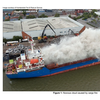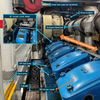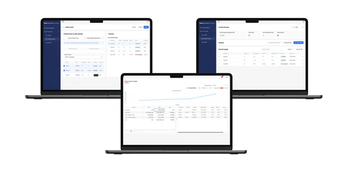One if by Land
When contractors Brasfield & Gorrie accepted a job to rehabilitate a dam for a local power company, their first foray into marine work was far from routine. With no navigable passage into the deep-water side of the 150-ft. tall dam, most workboats couldn't even reach the job site. The Birmingham, Ala.-based company decided a new equipment purchase was their best option. They bought a 25.3 x 14 x 4.5 ft. tugboat and transported it in two pieces that were offloaded by crane and assembled on site. What this job required was a truckable tug. And as the company soon learned there were many more jobs that could take advantage of such a tug. Since that initial investment of approximately $100,000, waterway work has become a nearly two-million-dollar segment of Brasfield & Gorrie's yearly operations. The tug's truckability has proved essential to gaining new business, doing work that other boats can't do.
The last decade has seen an brisk upswing in the market for trailerable workboats. From independent contractors starting residential dock businesses, to inland lake and reservoir tenders, to land-based construction crews breaking into marine work more companies are choosing truckable tugs.
When Stewart Sumpton bought Marine Inland Fabricators in 1989, his Panama City, Fla.-based company was one of only two in the country specializing in these boats. "Now there are five or six," says Sumpton. "The business has become incredibly competitive."
Dickey Tassin would agree. "The truckable market is booming right now," says Tassin, the owner of TMT Tassin's Marine Transportation who recently expanded his broker business into boat manufacturing with his New Orleans-based company Ahoy Marine. "We've seen a steady increase in sales."
One reason for growth is that even small companies are expanding, bidding on jobs outside their local area. While it might seem counterintuitive to ship a boat over the highway, oftentimes transporting marine equipment on land is less expensive. Simply put: rivers run crooked. So when fuel and crew costs get factored into the difference in mileage between a straight shot over the highway versus a winding path upriver, trucking often wins out.
Tassin offers one example: "Say you're in New Orleans and you need to go to Tampa. To hire one small tug and one small barge to ship equipment will run you about $25,000, but to truck one of these boats will cost only $6,000. You only come out ahead by water when you're shipping a substantial amount of equipment."
Another cost to be factored into the use of trailerable workboats, however, is the price of trucking permits, which vary state to state and based on the width of the load. Because trucking laws can be complicated, at Marine Inland Fabricators Sumpton hires trucker specialists to deal with the legalities state to state.
When Ken Cavanaugh's new 40 x 16 x 3.75-ft. truckable tug, Grapple, arrived in Mamaroneck, N.Y. from Marine Inland Fabricators it was split on the back of two trailers - pilothouse on one, hull on the other. At 16 ft., the boat pushed the limits of what's considered truckable. Grapple, like Marine Inland's other trailerable tugs bolts together at the pilothouse, which is completely detachable. Though the Grapple is a bit too large for frequent shipping, others of Marine Inland's boats are much more mobile.
Brasfield & Gorrie's tug is one example. Civil engineer John Chambliss says trucking the 25-footer is a relatively seamless operation. With a four-person crew, including the crane operator, the pilothouse can be detached and loaded onto a truck in less than a day. It then takes another day to offload and reassemble it on site, including hooking up the motor and steering equipment.
In addition to mobility, another truckable tug selling point is size. Not only are these small vessels versatile in shallow waters (many draw a mere three to three-and-a-half feet) but boats shorter than 26 ft. do not require a licensed pilot. According to Title 46 U.S. Code 8904, an uninspected commercial vessel under 26 ft. long can tow without licensed operators. For companies like Brasfield & Gorrie who are new to marine work, and for contractors with small crews, licensing flexibility is often an important consideration.
For boat builders, balancing cost and quality is a perpetual challenge. Yet some manufacturers say price points, more than any other factor, make or break truckable tug sales. "A tremendous number of customers buy on price. They don't even look at the boat before they buy it," says Sumpton. The reality is that many buyers are small start-up dock builders who don't have the flexibility to pay more for better quality. "For some the $5,000 or $6,000 is too much of a difference."
Tassin says 70 percent of his sales go to small contractors, many of whom cater to people living in waterfront communities who need dock work and dredging. Truckable tugs are "a cheap option for a guy who wants to start a construction business by buying one little boat."
While a 60-ft. harbor tug rated at 1,000 hp can cost as much as $900,000, many trailerable workboats run under $100,000, explains Jim Robinson of Marine Builders, which just began production of its first truckable tug this year. While its core business is building larger vessels, the Utica, Ind.-based company spotted a new market in these small boats and hopes to establish a steady production line of its first model, Workhorse. At 25.5 x 5 x 12-ft., the boat boasts independent steering and flanking rudders for maneuverability, standard rudder and shaft bearings, and an abrasion-blasted, all-steel hull.
While some companies emphasize quality workmanship, others respond to pricing pressure by building as cheaply as they can. Manufacturers say it can be difficult to convince customers that a higher quality boat will cost less in the long run. "I tell them you get what you pay for," explains Tassin. "That's kind of why I got into [manufacturing]. I was selling used boats that were falling apart after five years." He says Ahoy Marine's tugs are designed to last 15 to 20 years, and longer with good maintenance. Tassin recommends that customers pay more attention to the longevity of equipment by examining the construction methods and the type of framing used. He warns potential customers: "Five years down the line you'll need to spend $20,000 to maintain [a lower quality] boat while you might spend only $2,000 on mine."
In addition to quality, Sumpton focuses his company's manufacturing efforts on customization. "We try to get away from the cookie cutter approach. We work with the customer to change the design to suit his peculiarities … to make it fit his exact needs."
Another big consideration for many buyers is horsepower. When deciding on the specifications for the 25-footer, Chambliss stressed his priority to get as much horsepower as possible within the dimension limitations of a truckable boat. But, "horsepower is only one component of the drive train," Sumpton explains. To ensure efficiency, he says, you need to take into account engine RPM, reduction gear ratio, and propeller type. Designing a boat that strikes an appropriate balance among these will provide the maximum bollard pull, or pulling power.
One more consideration is the quality of the ship fittings and the welding. "Welding isn't just welding. You can have good welding and you can have crappy welding," says Sumpton, adding that his company uses 50 percent more weld than ABS rules require for inland use. "People always ask about hull thickness, but that accounts for less than half the strength of the hull," he adds. Also important in gauging strength is examining the framing, stiffening angles and trusses. "Look at the structural integrity of the hull and the continuity of strength throughout the hull," he recommends.
Besides money, what do customers seem to ask about most? Sumpton laughs and says: "Paint. Even in government spec sheets there are pages and pages on the paint job. But there's a heck of a lot more going on with building a boat than the paint." By Jessica DuLong, with reporting assistance from Tim Ivory, a marine diesel mechanic based in New Jersey A freelance journalist who has written for Newsweek International, Rolling Stone, Parenting and Newsday, among other publications, Jessica DuLong is also an engineer on retired 1931 New York City fireboat John J. Harvey.











